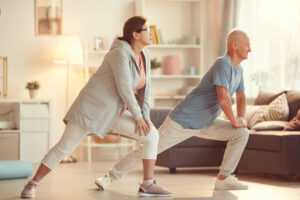Healthy Legs Help with Overall Health: Fall & Winter Tips
If exercise could be marketed as a pill, it would be the least expensive yet the most far-reaching medication ever; people would demand to have it. One reason we love summer is the many opportunities it provides for fun outdoor activities. With colder weather on the way, and the challenges presented by the pandemic, it may be harder than ever to stay active this fall and winter. That’s why we want to highlight how healthy legs can contribute to your overall health, and provide some tips to help you stay active at home, especially in light of continuing social distancing guidelines.
Year-Round Activity is Important
 Most people feel better about themselves when they are physically active on a regular basis. And decades of studies have shown that numerous health metrics across the board—mental health, immune system, body mass index (BMI), cardiovascular health, sleep, longevity—also improve. There are relatively few human-made medications in comparison that have as high-grade scientific evidence for health benefits as does regular exercise. That’s why it’s important to find ways to stay active all year.
Most people feel better about themselves when they are physically active on a regular basis. And decades of studies have shown that numerous health metrics across the board—mental health, immune system, body mass index (BMI), cardiovascular health, sleep, longevity—also improve. There are relatively few human-made medications in comparison that have as high-grade scientific evidence for health benefits as does regular exercise. That’s why it’s important to find ways to stay active all year.
As we head into fall and winter, setting yourself up for regular exercise will help you better withstand the physiologic changes that come with the change of seasons. If you are able and cleared by your physician, aerobic exercise is most beneficial, with the goal of increasing your heart rate to the “target rate” of 50% to 85% of your “maximal heart rate” (which can be approximated by the number 220 minus your age).
Healthy legs play a major role in maintaining your overall health. Up to 40% of people have some sort of venous insufficiency, and the related leg pain, swelling and discomfort, makes it harder to remain active and increases the risk of becoming overweight or obese.
3 Tips for Healthy Legs this Winter
We tend to be more sedentary in the late fall and winter as cold, snow and ice make it harder to be active outdoors. And with the current pandemic, gyms or mall-walking, may be problematic.
The circulation in your lower legs depends on the contraction of your calf muscles to help pump blood through your venous system. Regular contraction of these muscles is required to help return the blood back to the heart more efficiently. When this doesn’t happen, blood tends to pool in the veins in your legs, ankles and feet, which can lead to venous insufficiency, varicose veins, leg swelling and even blood clots.
To help with your leg circulation this winter:
- Wear compression stockings, even indoors. There are lots of choices for compression stockings now that are comfortable, fashionable and easier to put on.
- Do simple exercises that pump your calf muscles. We offer a series of six short videos demonstrating simple movements you can perform, including some you can do while sitting, to help prevent pooling of blood in your lower legs.
- Make time to incorporate some aerobic physical activity into your day, even if you have to schedule it. There are lots of videos you can stream or exercise equipment you can purchase so you can safely exercise at home.
If you are already struggling to stay active due to leg pain, cramping and heaviness, call us to schedule an appointment for an evaluation and treatment options that can help. We have taken exceptional precautions to ensure our status as a Non-COVID-19 Care Facility, so you can feel very safe coming in.

